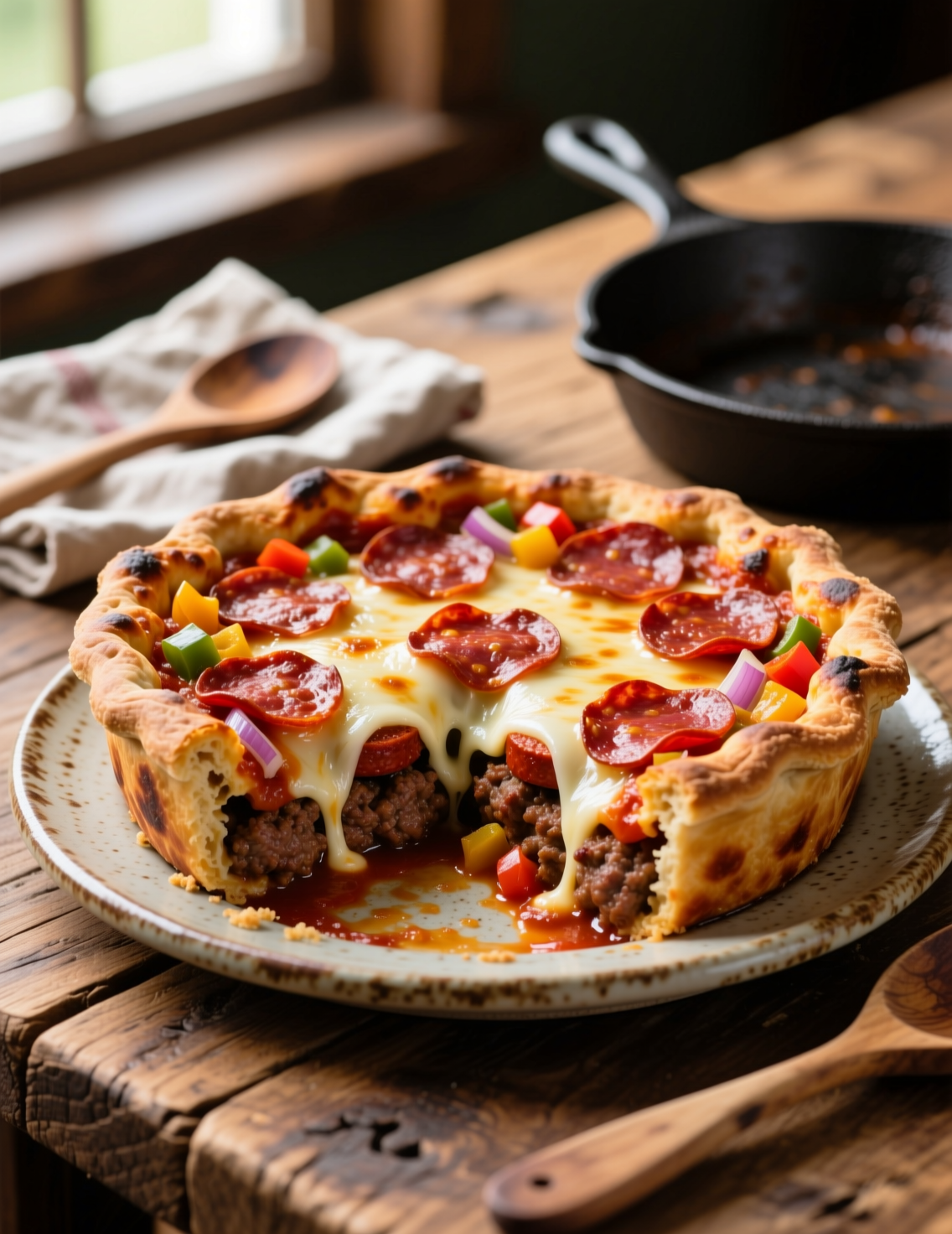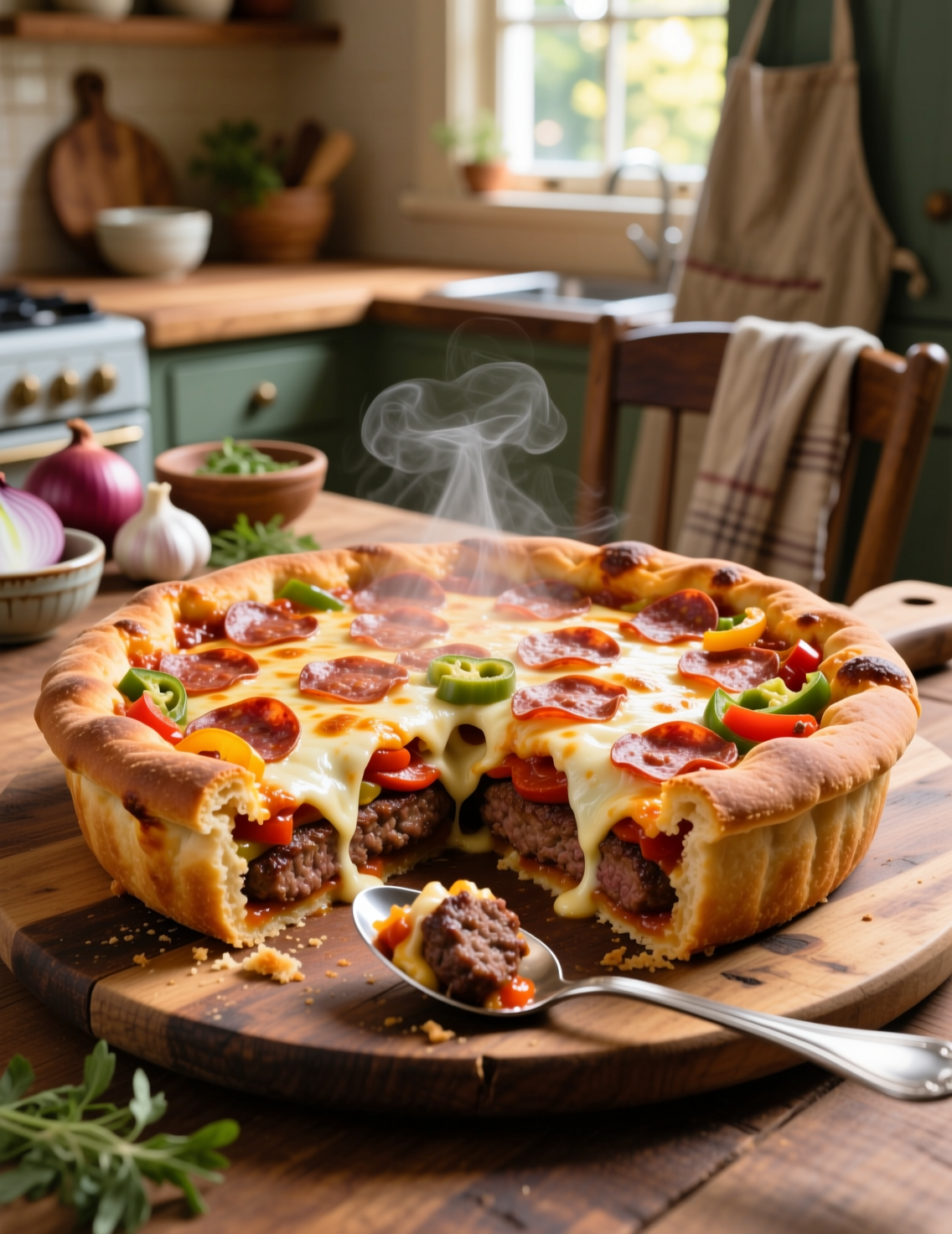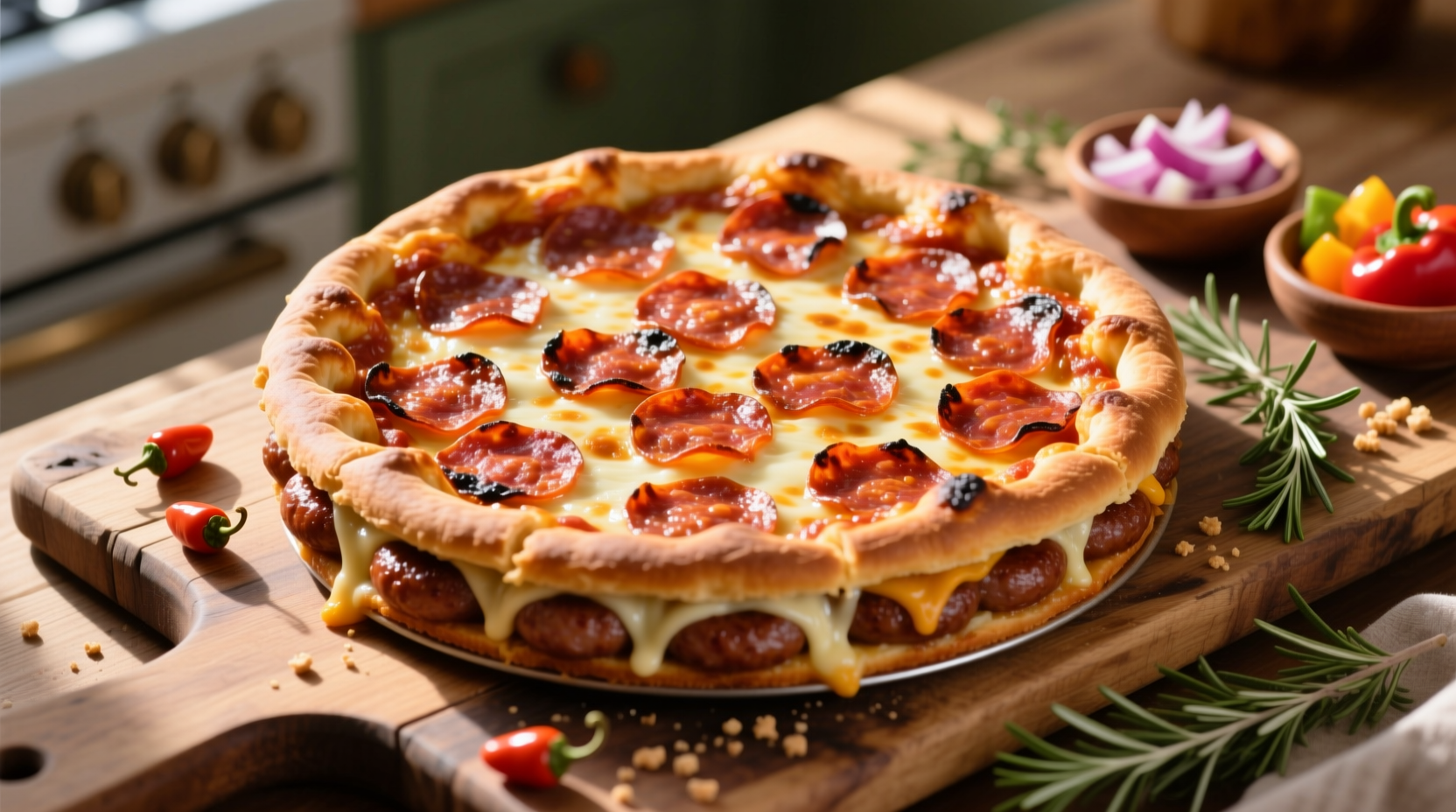There’s something unruly yet comforting about a pie that doesn’t apologize for being loaded. The deep-dish hamburger sausage pepperoni pie isn’t light fare. It’s the kind of dish you build when hunger laughs at moderation. This recipe is crafted for professionals who want more than just a “pizza casserole.” We’re talking layered meat, structured dough, controlled fat, and big flavor engineering.
Why This Pie is Different
At first glance, you might think this is just Chicago-style deep dish with more meat. Not quite. The base is thicker, almost like a fortified bread crust that can handle juices from ground beef, spicy sausage, and the pepperoni’s fat without collapsing. If the crust can’t carry weight, the entire pie becomes a soggy mess. Professionals know: moisture management is half the battle in deep savory pies.
We also bring balance into play. Yes, you’ve got fat on fat, but tomatoes cut through, and a well-thought-out spice profile stops this from being greasy chaos. Think of it as designing an ecosystem, not just piling meat.
Ingredients That Actually Matter
Most recipes toss out a grocery list, but let’s talk decisions. Every ingredient is chosen for a reason, not just tradition.
The Crust
Flour matters. High-protein bread flour gives better gluten development, meaning chew and strength. All-purpose flour will do if you’re stuck, but don’t expect the same lift. Cornmeal, about 2 tablespoons, adds grit and a rustic backbone.
Yeast should be instant for professionals working fast, but active dry works if proofed. Sugar isn’t just sweet—it feeds yeast, helps browning, and balances acidity in the sauce later.
The Meat
Hamburger meat must sit around 80/20. Too lean, and you’ve got dry pebbles inside a glorious pie. Too fatty, and you drown your crust in grease. Italian sausage, mild or hot, brings fennel and spice oils that bloom inside the pie as it bakes. Pepperoni is less negotiable—thick-cut slices release more oil, creating that signature orange gloss that whispers indulgence.
The Cheese
Mozzarella, full-fat block shredded by hand. Pre-shredded bags are coated with anti-caking starch that messes meltability. A bit of provolone sharpens the base. Some professionals sneak in low-moisture Parmesan between meat layers—it traps flavor like a sponge.
The Sauce
San Marzano tomatoes aren’t hype. Their balance of sweetness and low acidity helps when you’re dealing with salty meats. Crush them by hand, don’t blend. A chunky sauce holds better and won’t seep into your crust as much. Garlic sautéed in olive oil before adding tomatoes builds depth. Oregano, basil, and a pinch of chili flakes complete it.

The Build: Layering is Science
Professional kitchens understand: how you layer determines how the pie eats. Cheese always hits the dough first. Why? It melts into the crust, creating a moisture barrier. Meat comes next, spread evenly, never clumped. Gaps mean steam pockets, and steam wrecks crust.
Sausage should be par-cooked. Never raw. Raw sausage in a deep pie can leave undercooked bits inside, especially if baking at lower temps. Pepperoni goes on top of sausage, because it crisps slightly and prevents pooling grease from soaking cheese. Sauce crowns the stack, but not too much. This isn’t spaghetti—it’s a pie, and oversaucing sinks it.
Cooking Method: Heat and Timing
A 425°F oven is ideal. Lower than that and meats sweat without browning. Higher than that and crust scorches before insides settle. Bake on the lower rack—closer to heat source means your bottom crust won’t stay pale. Professionals often use cast iron pans, not springform tins. Cast iron distributes heat evenly and locks in that golden base.
Time is around 35–40 minutes, but don’t clock-watch only. You want visual and aromatic cues. Bubbling edges, oil popping on top, and that unmistakable toasted cheese scent means it’s close.
Resting is crucial. Cut too early and you’ll face a lava flood of cheese and fat. Let it rest 15 minutes minimum before slicing.
Step-by-Step Recipe for Professionals
Dough Preparation
- 3 ½ cups bread flour
- 2 tbsp fine cornmeal
- 2 tsp sugar
- 1 packet instant yeast (7g)
- 1 ¼ cup warm water
- 3 tbsp olive oil
- 1 tsp salt
Mix dry ingredients, add water and oil. Knead until smooth. Rest covered for 1 hour. Punch down, roll into a 14-inch round, line your deep pan. Leave dough hanging slightly over edges; it shrinks back.
Sauce
- 1 can San Marzano tomatoes (28 oz)
- 2 cloves garlic, minced
- 2 tbsp olive oil
- 1 tsp dried oregano
- ½ tsp chili flakes
- Handful fresh basil, torn
Heat oil, sauté garlic. Add tomatoes by hand, simmer 20 minutes. Stir in herbs at the end.
Filling
- 1 lb ground beef (80/20)
- 1 lb Italian sausage, par-cooked
- 1 cup thick-cut pepperoni
- 3 cups mozzarella, shredded
- ½ cup provolone, shredded
- ¼ cup Parmesan
Brown beef with a pinch of salt. Drain excess fat but not all—some fat carries flavor. Crumble sausage into chunks.
Assembly
- Line crust with mozzarella + provolone.
- Add beef, spread evenly.
- Scatter sausage over.
- Add Parmesan dusting.
- Layer pepperoni.
- Spread tomato sauce.
- Sprinkle final mozzarella over sauce.
Baking
Place in preheated oven at 425°F, lower rack, 35–40 minutes. Tent with foil if browning too quickly. Rest before slicing.

Professional Tips and Pitfalls
One common mistake is thinking more cheese equals better. Past a point, cheese just leaks oils and overwhelms. Optimal cheese load is about ½ pound for an 8-serving pie.
Another trap is sauce thickness. If sauce runs too thin, reduce longer. Too thick, and you end with dry bites. Aim for a viscosity where a spoon dragged through leaves a streak that holds 2–3 seconds before closing.
Crust sogginess? That usually means insufficient bottom heat or skipping the cheese-first rule. Professionals often brush the dough with egg white before adding fillings, creating an extra seal.
Flavor Variations for Experts
Want smokier tones? Replace half the sausage with Spanish chorizo. Need earthy depth? Add roasted mushrooms between layers. Some chefs drizzle hot honey on top post-bake—a surprising trend that cuts through fat beautifully.
For service, consider pairing. A bitter green salad with vinaigrette balances heaviness. For wine, a Chianti or Zinfandel can stand up to the meat, while beer-wise, a hoppy IPA cuts grease with bite.
Why This Works in Modern Menus
Deep-dish pies aren’t fast-food anymore. Restaurants price them as shareable centerpieces, often $28–$35 for 8 servings. Customers see them as an experience, not just dinner. According to Datassential, meat-heavy comfort dishes grew 14% on U.S. menus from 2021 to 2024. This pie fits perfectly in that trend.
In catering, a deep pie holds heat longer than thin-crust pizza. That stability matters when serving 50 plates without re-firing constantly. Professionals bank on that efficiency.
Addressing Misconceptions
Many home cooks fear deep-dish pies are “too greasy.” The grease problem isn’t from meats alone, but poor balance. Professionals know how to manage fat—par-cook sausage, drain beef, and use quality pepperoni. Done right, the pie is rich but not dripping.
Another myth is that these pies are impossible outside Chicago. Truth is, any good oven and the right layering technique makes it work. Chicago is heritage, not a boundary.
Conclusion
The ultimate deep-dish hamburger sausage pepperoni pie is more than a recipe—it’s controlled excess. The crust stands tall, the meats weave flavors, and the sauce balances it all. Professionals understand that success lies in precision, not just loading ingredients. Layer right, bake smart, rest long.
Serve this pie when the table needs silence. That moment when forks dive in and nobody speaks for five minutes? That’s when you know the craft worked.
FAQs
Can I use store-bought pizza dough for this pie?
Yes, but homemade dough with bread flour holds structure and flavor better.
Should the sausage be cooked before baking?
Yes, always par-cook sausage to avoid undercooked meat in the pie.
Why does cheese go on the crust first?
It creates a barrier that prevents sauce and meat juices from soaking the crust.
Can I substitute pepperoni with another meat?
Absolutely, chorizo or salami work well for variation.
How do I stop the crust from turning soggy?
Bake on a lower rack, start with cheese on the dough, and avoid thin sauce.
What pan works best for deep-dish pies?
Cast iron pans are preferred because they distribute heat evenly and brown the base.
How long should the pie rest before slicing?
At least 15 minutes, so the layers set and don’t collapse.
Is pre-shredded cheese okay?
Not ideal, as anti-caking agents prevent smooth melting—always shred fresh.
Can I freeze leftovers of this pie?
Yes, cool completely, wrap tightly, and freeze for up to 2 months.
What’s the best drink pairing with this dish?
A bold red wine like Chianti or a hoppy IPA balances the richness.

Mariana is a passionate home cook who creates delicious, easy-to-follow recipes for busy people. From energizing breakfasts to satisfying dinners and indulgent desserts, her dishes are designed to fuel both your body and hustle.
When she’s not in the kitchen, she’s exploring new flavors and dreaming up her next recipe to share with the Foodie Hustle community.

